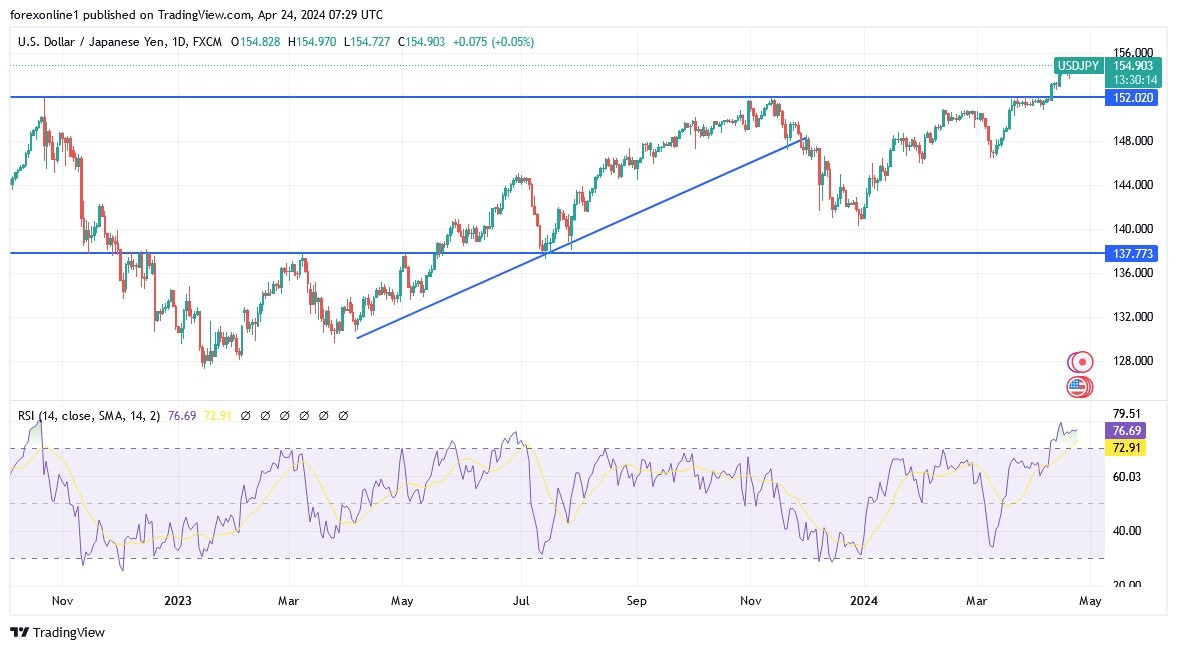- Despite daily Japanese warnings about the imminent date of intervention in the Forex currency markets to prevent further collapse of the Japanese yen exchange rate, the upward trend of the price of the US dollar against the Japanese yen “USD/JPY” is getting stronger.
- It is currently around the 155.00 resistance, its highest level in 34 years.
- Currently, it seems that the markets see the intervention as being verbal now. In addition to intervention in currency markets, the Bank of Japan is widely expected to leave its benchmark interest rate unchanged next Friday, with investors focusing on any hints of a less pessimistic bias with the yen trading around its lowest level in 34 years.
Governor Kazuo Ueda and his fellow board members are expected to keep Japan's short-term interest rate at around 0% to 0.1% at the end of the two-day policy meeting, after the Japanese central bank paused its massive monetary easing program last month, according to all the economists surveyed.
Just five weeks into this massive shift, Ueda faces the challenge of striking a delicate balance between setting a floor for the yen while also supporting the fragile economic recovery. In general, the yen has surprised Japanese authorities by falling even after Japan raised interest rates for the first time since 2007. A weak currency could fuel inflation caused by rising costs, and some executives at companies that have benefited from the lower currency have begun to express concerns about the overall impact.
This has left market players more focused on whether the bank might send a clearer signal for policy normalization this time. In this regard, Ryutaro Kono, chief Japanese economist at BNP Paribas SA, said: “The risks are increasing for early loading of interest rate hikes in June or July.” He added, “The Japanese yen is likely to continue to decline gradually,” as the government believes that intervention is insufficient to change course considering the strong American economic data and the escalating geopolitical risks in the Middle East.
For his part, the Japanese Finance Minister repeated his warnings against excessive currency movements during his appearance before Parliament on Tuesday. Shunichi Suzuki said, “I think it is fair to assume that the environment is appropriate to take appropriate action on Forex, although I will not say what the action is.”
The Bank of Japan's latest quarterly inflation forecast, and its risk assessment are among the easiest ways for the central bank to exploit the possibility of an early rate hike. Other potential areas include bond-buying plans and the language the central bank uses to describe its purchases, according to some market watchers.
The Bank of Japan governor has not ruled out responding to exchange rates through policy action if the impact on prices is "non-negligible." The yen fell to 154.85 against the dollar overnight, its weakest level since June 1990. Traders are on high alert for the possibility of Japanese officials returning to the market to buy their country's currency, as they last did in 2022. For now, the Bank of Japan's policy continues to weigh on the yen. Ueda has reiterated that he expects financial conditions to remain easy to ensure that there is no market disruption or economic recovery caused by the Bank of Japan's policy pivot. Also, analysts say this message may have resonated strongly with markets.
Overall, bets by leveraged funds and asset managers on yen weakness have increased to over 173,000 contracts as of April 16, the highest on record in Commodity Futures Trading Commission data since 2006. Also, it is the largest short position among nine major currencies, according to Bloomberg calculations. This makes the yen vulnerable to a sudden rebound if the trend changes.
In addition, the recent rise in oil prices, coupled with the surprisingly strong results of spring wage negotiations, make it almost certain that inflation forecasts will be revised upwards. As a result, three-quarters of Bank of Japan watchers say that assessing the balance of risks, and whether upward risks have been highlighted, will be more important than usual this time. The bank said price risks were "generally balanced" in its previous January report.
Overall, any move by the Bank of Japan to support the yen could be overshadowed after a few hours of the policy announcement, with the US Federal Reserve's preferred inflation reading due out next week and Federal Reserve Chairman Jerome Powell taking centre stage as the US central bank wraps up its May 1 meeting.
Top Forex Brokers
USD/JPY Technical analysis and Expectations Today:
Technically, the general trend of the price of the US dollar against the Japanese yen “USD/JPY” is still bullish, and its gains were sufficient to push all the technical indicators towards strong overbought levels. Therefore, we still prefer to sell the dollar against the yen from its current and higher record gains without risk. In the event of a Japanese intervention in the markets, it may the currency pair is exposed to strong selling operations to take profits, with the trend quickly turning downward.
Ready to trade our Forex daily forecast? We’ve shortlisted the best forex broker list for you to check out.


